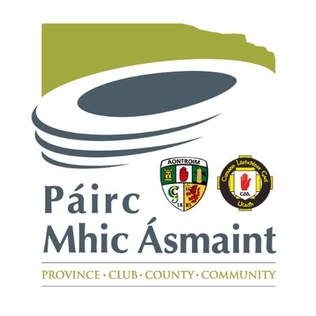
Ballybrittas is a small village in the northeast of County Laois, Ireland situated on the R445 about 5 km SW of Monasterevin, County Kildare. Formerly on the N7 Dublin - Limerick road, the village is now bypassed by the M7 motorway.

Casement Park is the principal Gaelic games stadium in Belfast, Northern Ireland. It is located in Andersonstown Road in the west of the city, and is named after the Irish revolutionary Roger Casement.

Croagh is a small village and civil parish in County Limerick, Ireland. It is located in mid-Limerick between Rathkeale and Adare just off the N21 national primary road, approximately 22 kilometres south west of Limerick City. The village was originally part of this route before construction of the Croagh by-pass in 1986. The village is in the agricultural area known as the Golden Vale.

Ballingarry is a village in County Limerick, Ireland. It is located near the village of Granagh and between the towns of Rathkeale and Kilmallock on the R518 road. Ballingarry lies in a civil parish of the same name, and within the ecclesiastical parish of Ballingarry-Granagh in the Roman Catholic Diocese of Limerick. The village had a population of 570 as of the 2022 census, up from 521 at the 2016 census.

The Ballyhoura Mountains are in south-east County Limerick and north-east County Cork in central Munster, Ireland, running east and west for about 6 miles on the borders of both counties.

Hugginstown is a small village and townland in south County Kilkenny, Ireland. The local Gaelic Athletic Association club, Carrickshock GAA, play their home games in the village.

Ballinahown, also spelled Ballynahown, is a village in County Westmeath on the N62 regional road in Ireland. It is 10 km (6.2 mi) south of Athlone and 5 km (3.1 mi) east of the River Shannon. It contains the Roman Catholic St. Colmcilles Church, completed in 1902 to a design in the Early English Gothic-style by William Hague.

Tadhg Crowley was an Irish revolutionary and Fianna Fáil politician. He was first elected to Dáil Éireann as a Teachta Dála (TD) for the Limerick constituency at the June 1927 general election.
Glenroe Hurling Club is one of the oldest clubs affiliated to the Gaelic Athletic Association. It plays hurling and formerly gaelic football. It plays in competitions organized by Limerick GAA. Located in the Ballyhoura Mountains, County Limerick, Ireland, local parish teams played hurling games from long before the famine of the 1840s and local teams played before the GAA's foundation.
The Ballyhoura Way is a long-distance trail in Ireland. The trail is 89 kilometres long; it begins at St John's Bridge, near Kanturk, County Cork and ends at Limerick Junction, County Tipperary, and is typically completed in four days. It is designated as a National Waymarked Trail by the National Trails Office of the Irish Sports Council and is managed by Ballyhoura Fáilte. The trail was opened in April 1994 by President Mary Robinson.
Garryspillane GAA club is a Gaelic Athletic Association club located in the parish of Knocklong/Glenbrohane, County Limerick, Ireland. The club was founded in 1952 and is almost exclusively concerned with hurling with footballers catered for by neighbouring Galbally.
Ballylanders GAA is a Gaelic Athletic Association (GAA) located in the parish of Ballylanders/Knockadea in County Limerick. The club was founded in 1888 and is solely a Gaelic football club as hurlers from the parish play with neighbouring Glenroe. They won the County Senior Football Championship on four occasions in 1917, 1999, 2007 and 2014.

Frank Brazil Dineen was a Gaelic games administrator and the fourth president of the Gaelic Athletic Association. From Ballylanders in County Limerick, he was elected General Secretary of the GAA in 1898 and is the only man to have ever held the two top positions within the Association. An athlete in the 1880s, Dineen was the fastest Irish sprinter of his day. He was also a founder of Ballylanders Shamrocks. He is also noted as the man who purchased a site on Jones Road in 1908 before donating it to the GAA for free in 1913, the site now of Croke Park. Dineen held the ground in trust for the GAA, which at the time was not able to purchase the land itself. Between 1908 and 1910 he oversaw development of the ground, paying for the improvements himself.
Gearóid M. Hegarty is an Irish hurler and Gaelic footballer who plays as a right wing-forward for club side St Patrick's and at inter-county level with the Limerick senior hurling team. He is a former member of the Limerick senior football team.

Ballyneety is a village in County Limerick, Ireland, located approximately 10 km from Limerick city.

Peter William Crowley was an Irish revolutionary and hunger striker, holding the Guinness World Records for the longest hunger strike in history. From 11 August to 12 November 1920, Crowley, along with 10 others, underwent a hunger strike for 94 days in Cork County Gaol, demanding the reinstatement of their political status and release from prison. The 1920 Cork hunger strike took place at the same time as that of Terence MacSwiney, Lord Mayor of Cork.

Timothy Crowley was an Irish revolutionary who was a member of the Irish Republican Brotherhood (IRB). He was involved in the Fenian Rising of 1867, and was the secretary of the IRB in Hospital, County Limerick. He was the patriarch of the prominent Irish republican Crowley family of Ballylanders, and the father of the longest hunger strikers in history, John Crowley and Peter Crowley, and the Fianna Fáil Politician Tadhg Crowley.
Ballymacoda is a small village in County Cork, Ireland. As of the 2016 census, the village had a population of 185 people.

Ballysteen is a small village and townland in County Limerick, Ireland. It is located in the civil parish of Iveruss and the historical barony of Kenry.
















